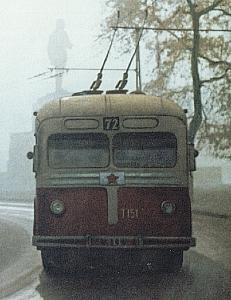 |
|
|
|
|
The MTB 82 trolleybus |
|
 |
|
|
| On 26th October 1949 arrived the first shipment of the MTB 82 trolleybuses,
on 1st December the 25th was in Budapest. One more vehicle above these
was bought: the exhibitor car of the BNV (Budapest International Fair)
of 1949.
The official exam of the first trolleybuses was on 24th November 1949. The numbers of the the first trolleybuses became T100-T125. The public opening was on 21st December, on the 70th birthday of Stalin. Possibly the meaning of the new line number 70 should not be further explained... Though originally the line was planned to be opened on the 32st anniversary of the Sowiet Revolution on 7th November, but the construction works were delayed. Until 1953 further MTBs were bought:
|
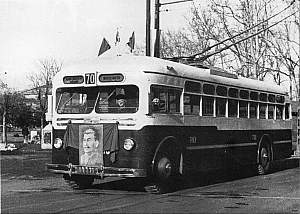 The first... The T100 on the opening ceremony of line 70. |
||||||||||||
| In the Sowiet Union the production of trolleybuses started in 1936
in the city ofJaroslavl (that is situated near the river Volga). During
the war the Auto-Motor Institute made uniform plans of autobuses and trolleybuses;
the look of the cars werevery similar to the products of the US company
General Motors. After the war the first of the type JaTB-4 was made in
Jaroslavl. Soon the production was movedto the Moscow (Tushino) Airplane
Factory (Moscowsky Aviatsiony Zavod '82); the nameMTB 82 was the abbreviation
of Trolleybus of Moscow. The first 28 pieces to Budapest were made here.
On 28th February 1950 the Minister Council of the Sowiet Union assigned the "Uritsky" factory in the city of Engels for production of trolleybuses (the city ofEngels is also along the river Volga opposite to Saratov). The first trolleybus was ready on 1st May 1951. This was the origin of the 1952 series of MTB's to Budapest, which could have also bear the name ZIU (Zavod Imeny Uritskowo). |
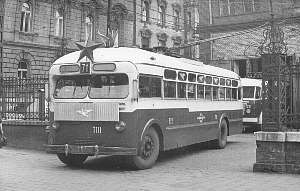 The T111 trolleybus in the '50s at Damjanich depot- again in festival outlook |
||||||||||||
| In the '50s the official propaganda made a cult around these trolleybuses.
Forexample the newspapers at the time wrote about an accident, where "a
notorious driverdestroyed the wonderful present of comrade Stalin and the
Sowiet Union".
Then in the revolution of 1956 two MTB trolleybus (T139, T140) was damaged so badly during the fights, that in 1957 they were scrapped. On the 19th June 1958 at the line 71 the sitting conductor service was introduced experimentally. For this reason five MTBs' body were modified: they obtained wider doors and the frontal look was redesigned too. Later the sitting conductor service was also used on cars without rebuilding, until the tariffication reform in 1966. |
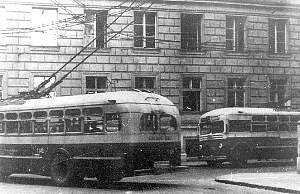 At the end of Kálmán Imre utca (street) the T145 and another MTB trolleybus. In the '50s at the rear tram shields were used on the bumper. In the '60s the shield were put behind the rear windscreen. |
||||||||||||
The remaining 51 cars were scrapped between 1964-67, instead of them
new ZIU-5 trolleybuses were bought. The last of them (scrapped in 1967)
were in service on 31st December 1966 on line 79: these were T103,
T130, T131, T135, T137, T151.
Not all of the trolleybuses were taken apart, some of them became trailer of lorries. This way escaped one MTB 82, which is today at Pongrác depot. It is in a bad condition, the renovation is set back since the lack of money. |
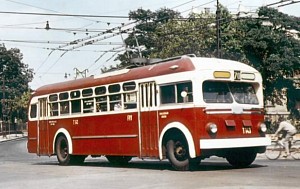 The T143 at Május 1. út (street - today Hermina út), in the '60s. In the '60s the pattern of the coloration was changed. |
|
|
|
|
|
|
|
|
|
|
|
|
|
|
|
|
|
|
|
|
|
|
|
|
|
|
|
|
|
|
The construction was a typical example of the non-self-carrying body: it had a heavy chassis with a built on body. The look of the trolleybus was very similar to the US PCC trolleybuses.
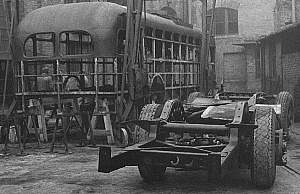 |
|
From the homepage of Zoltán László
|
The side windows were the typical PCC standee windows, they could be
opened by pulling up.
Inside there were double seats in two row, which made the flowing of
the passengers slower. The driver's cabin was quite large, wich was separated
from the room by a telescopic door.
On the MTB 82 there was missing the servo for steering, in slow motion the steering was heavy. The driver had to be conscious about this in the traffic (especially at the stops). At larger speeds the steering meant no difficulty.
The vehicles had 6 m long steel trolleys, this allowed 4.5 m deviation from the poles. In case of running away too much from the middle, there were lamps signalling the problem. The trolleys were pushing up with the force equivalent of 10 kg. The trolleys had coal inserts to avoid the abrasion of the poles. The current flow through a electric noise filter inside to the electric equippments.
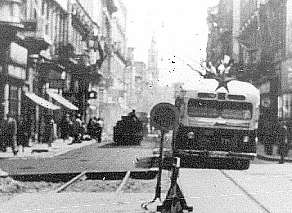 |
|
|
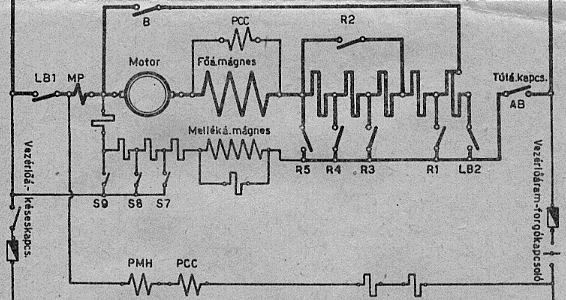 -
-
The acceleration had three stage: in the first cascade all the resistors
were inside the circuit with lower outer excitation. With this the trolleybus
started relatively smoothly. Then the excitation increased by operating
all S contactors, and cascade by cascade all the resistors were
short-circuited by the R contactors. In the 8th cascade there was
full excitation and no resistors left in the main circuit. With this the
trolleybus ran 20 km/h. In the last stage of the acceleration the three
S contactors released decreasing the outer excitement: so this last 3 cascades
were shunting the motor. With this the vehicle increased its speed up to
50 km/h.
If the accelerator was pressed too rapidly, then the maximal relay
released the two line contactors LB1 and LB2. In this case
the accelerator pedal had to be released and start again the coupling.
If the line voltage disappeared (e.g. tramway crossings) the zero-voltage
relay came into action: the bell rang. The line contactors did not work
when the voltage returned while the accelerator pedal was pressed: this
way the harmful current-impulses were avoided.
It was possible to make a recuperative brake with the MTB. By releasing
the accelerator pedal back to the 8th cascade, the trolleybus decreased
its speed to 20 km/h with recuperation. If the network was not suitable
for recuperation the increasing voltage made PMH overpotential relay
to switch to rheostatic brake automatically (with shutting down every main
circuit contactors, and operating the B brake contactor). This way
the three shunt cascades were the three possible strength of the recuperative
brake.
Pressing the brake pedal caused to switch instantly to the rheostatic
brake. Then the B contactor short circuited the rotating part of
the motor through the resistors, and only the outer excitation circuit
remained under voltage. The strength of the brake was regulated by the
S contactors. This way the brake was smooth; to make a more efficient
brake the driver pressed the pedal to the air pressure brake stage. The
feeding of the excitation circuit caused a slight consumption of energy
from the pole (the maximal current was around 10 A), but also in case of
no voltage, the rheostatc brake did not work.
Though the electric equippment of the MTBs in Hungary
was uniform, not all the sowiet MTBs had the same system. There was an
MTB 82D type with the starter-regulation of the ZIU-5 and ZIU-9 types.
The most interesting was the variant of the MTBs, which had a motor where
the rotating part had doubled coils (i.e. the coal-brushes and the commutator
were also doubled). With this there was a possibility to make a serial-parallel
coupling with a single motor. Also there was a construction with an electric
equippment of serial-parallel coupling but with the normal motor. Here
in serial cascades the second motor was replaced by a large resistor.
The lights were fed from 550 V of the line voltage. This meant, that
on longer dead sections the lights went out, only the emergency lights
were lit. There were five bulbs coupled in series, alltogether there was
15 bulbs. A heating was also installed.
The MTB had a small capacity accumulator, which was charged from a dynamo on the motor-axle. The outside lights, the instrument panel, the horn, the waving arms and the bells were operating from 12 V. A curiosity amongst these are the waving arms, which were signalling the turns. In the late '50s these were replaced with blinking turn signals.
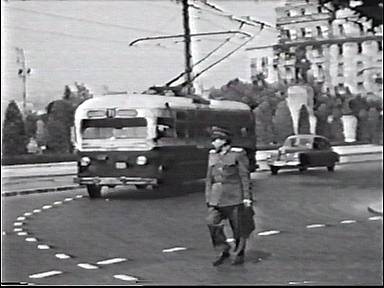 |
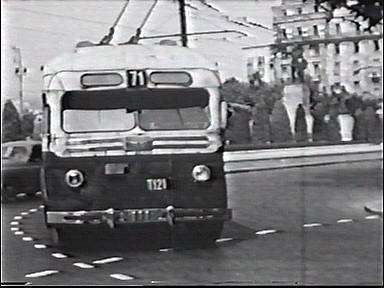 |
|
On the first picture near the left mirror the operating waving arm is visible. |
|
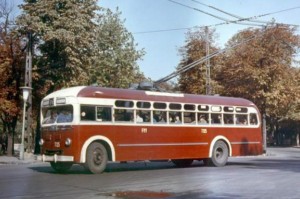 |
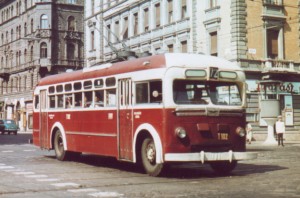 |
|
|
|
2005.XI.